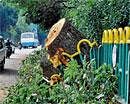

The team has urged for a thorough scientific assessment of environmental and social impacts of road-widening projects undertaken by the BBMP. They have also sought a verification for the claims of reduction in traffic congestion, before executing these “largescale, ill-designed, faulty and environmentally-damaging plans for massive road widening in the City.”
Endorsing the statement, the team has submitted their ‘public statement’ to the urban development minister, BBMP mayor and commissioner.
The public statement issued by Atree ecologists, Dr Harini Nagendra, Jahnavi Pai and Dr H S Sudhira says that the government needs to urgently assess the tree felling scientifically as the present road widening project is misguided, short-term and can be environmentally destructive.
The ecologists feel that the Palike’s approach to road widening as a solution to congested traffic by systematically felling trees on the periphery is unscientific and unsustainable.
Worldwide numerous scientific studies have pointed out that ‘supply side measures’ like road widening will not solve the problem of traffic congestion, but introduction of ‘demand side management’ measures like regulation of on-street parking and congestion tax would be much more useful to tackle congestion.
Urban biodiversity
Ecologists pointed that the trees that were felled along the bund of Sankey Tank included Syzigium, Tamarind and three species of Ficus, which were all important resources for supporting urban biodiversity. “This felling, unfortunately, represents just a small fraction of the massive loss in tree cover in the City,” they say.
A mega project of road widening has been planned for 216 roads in Bangalore simultaneously.
There is research demonstrating how street trees are crucial for a city, providing environmental services, reducing temperature and mitigating air pollution, providing important ecological habitats and corridors for many migratory and endangered species.
Ecologists further say that though BBMP claims to plant two or three saplings for each tree that is felled, these saplings are not planted on the same roads where felling is done, or even in publicly accessible areas. Instead they are planted in remote locations.
Moreover, the survival rate of these saplings is poor as it takes at least a couple of decades for them to grow and provide the same environmental and ecological benefits that these large felled trees provide today.
A sterile and concretised urban environment is not only unsustainable but also unhealthy for city-dwellers, the ecologists have stated.